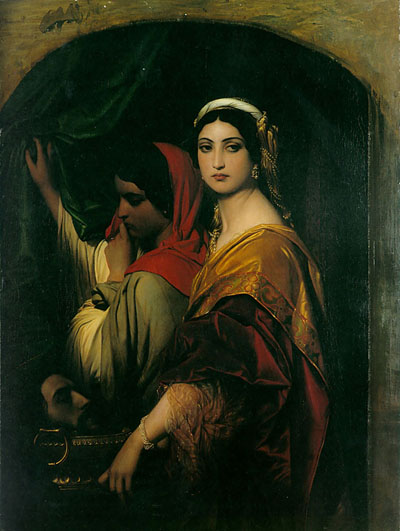

|
Erodiade, dipinto di Paul Delaroche (1797 – 1856) Erodiade (1843), painted by Paul Delaroche depicting "Erodiade ed figlia di Erodiade" (Erodiade and Erodiade's daughter). Public domain image imported from Wikipedia. |
This painting depicts and Italian Erodiade. The head of John the Baptist is almost invisible in the shadows to the right. The mid-19th century Italian painting references a biblical story, also referred to by Josephus, ANTICHITA 'Jews, Book XVIII: 136.
The daughter of Erodiade (Herodias) danced before them and pleased Erode (Herod the Tetrach of Galilee) so much that he promised with an oath to give her whatever she asked. And she, prompted by her mother, said, "Give me here on a platter the head of John the Baptist ..."Compare the figure of this dark-eyed beauty above with an image from Raven Grimassi's article on Aradia: Aradia - by Raven GrimassiLa figlia di Erodìade danzò in pubblico e piacque tanto a Erode che egli le promise con giuramento di darle tutto quello che avesse domandato. Ed essa, istigata dalla madre, disse: "Dammi qui, su un vassoio, la testa di Giovanni il Battista…"
A belief existed at least as early as the 9th or 10th century, as it is recorded in the Canon Epscoti. The Roman Goddess Diana became associated in the Italian legend of the Night Flight. The pagan Diana led the flight with certain women, who flew with Diana at night across vast distances.

By the 12th century, Erodiade (Herodias) joined Diana in the Night Flight. This belief is again recorded by Reginald Scot in the 16th century.
Certeine wicked women following sathans prouocations being seduced by the illusions of diuels, beleeve and professe, that in the night times they ride abroad with Diana, the goddesse of the Pagans, or else with Herodias, with an innumerable multitude...
--Reginald Scot, Discoverie of Witchcraft, 1584.
Herodias and Witchcraft - by Raven Grimassi
Erodiade Regina
Daughter of Herodias
The Dance of Herodias's Daughter
Aradia home page